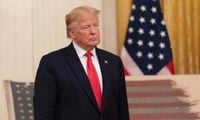On March 27, 2025, President Donald Trump signed an executive order aimed at reshaping the Smithsonian Institution, the world’s largest museum complex, by eliminating what he terms "divisive narratives" and "anti-American ideology" from its exhibits. This controversial move places Vice President JD Vance, a member of the Smithsonian's Board of Regents, in charge of overseeing the changes, which Trump insists are necessary to restore the institution to its original purpose as a symbol of American greatness.
In his executive order, titled "Restoring Truth and Sanity to American History," Trump criticized the Smithsonian for promoting narratives that he claims portray American and Western values as inherently harmful and oppressive. Specific institutions targeted include the National Museum of African American History and Culture and the forthcoming Women’s History Museum, both of which he accuses of fostering divisive ideologies.
"Museums in our Nation's capital should be places where individuals go to learn—not to be subjected to ideological indoctrination or divisive narratives that distort our shared history," the executive order states. The Smithsonian, which encompasses 21 museums and the National Zoo, has been a public-private partnership since its creation by Congress in 1846.
Trump’s directive comes on the heels of earlier actions taken by his administration to overhaul cultural institutions, including a February 2025 initiative to revamp programming at the John F. Kennedy Center for the Performing Arts. This latest effort reflects a broader push by Trump and his allies to reverse policies associated with diversity, equity, and inclusion (DEI) that gained traction under former President Joe Biden.
Under the new order, the Smithsonian will be prohibited from hosting or funding exhibits that "degrade shared American values, divide Americans based on race, or promote programs or ideologies inconsistent with Federal law and policy." This includes a ban on recognizing transgender women in the Women’s History Museum, which is still in development.
Vance is tasked with working alongside congressional leaders to appoint new board members who align with the administration’s vision of promoting a more sanitized version of American history. The executive order also directs Interior Secretary Doug Burgum to restore federal parks and monuments that have been altered or removed since 2020, potentially signaling a revival of Confederate monuments taken down in the wake of national protests against racial injustice.
Critics of Trump’s order argue that it represents an unprecedented attempt to control the narrative of American history and suppress diverse perspectives. Historians and educators have voiced concern that the push for ideological conformity undermines the integrity of historical scholarship. Chandra Manning, a professor at Georgetown University, expressed dismay at the notion that a comprehensive understanding of history could be viewed as a threat to national unity. "The American people are not so fragile as all that," she remarked.
Adam Rothman, another history professor at Georgetown, criticized the order for disrespecting the efforts of those who strive to present an accurate and nuanced portrayal of the nation’s past. “The president’s proclamation disrespects the thousands of sincere and dedicated researchers, curators, scientists, guides, interpreters, docents, and countless other people who work hard every day to preserve and tell the nation’s story truthfully,” Rothman stated.
The Smithsonian Institution has long been regarded as a cultural icon, attracting over 17 million visitors annually. It houses significant artifacts and artworks, including Thomas Jefferson’s desk and Jackson Pollock’s famous paintings. However, Trump’s executive order threatens to alter the institution’s trajectory by imposing a narrow ideological framework that could limit the scope of exhibits and educational programs.
In the order, Trump claimed that over the past decade, objective facts have been overshadowed by a distorted narrative driven by ideology rather than truth. He described the Smithsonian's evolving approach as a reconstruction of history that is "inherently racist, sexist, oppressive, or otherwise irredeemably flawed." This claim has ignited a heated debate about the purpose of museums and the role they play in shaping public understanding of history.
As part of the executive order, Trump also aims to restore Independence National Historical Park in Philadelphia, home to the Liberty Bell and the site of the signing of the Declaration of Independence. The order mandates that funding be allocated to improve the park's infrastructure in time for the 250th anniversary of the Declaration in 2026.
In anticipation of this anniversary, Trump’s order emphasizes the need for federal sites to remind Americans of their extraordinary heritage and the progress made toward becoming a more perfect union. However, the order's implications for how history is taught and represented in public spaces remain contentious.
Critics assert that the executive order seeks to erase the complexities of American history and silence voices that contribute to a fuller understanding of the nation’s past. The Smithsonian’s secretary, Lonnie G. Bunch III, has previously articulated the institution's commitment to presenting a nonpartisan view of history, acknowledging the importance of engaging with controversial topics and diverse perspectives.
As the Smithsonian navigates these new directives, the future of its exhibits and educational programs hangs in the balance. The challenge lies in maintaining its mission to educate and inspire the public while adhering to the administration's ideological mandates. The outcome of this struggle will likely have lasting implications for the portrayal of American history and culture.







